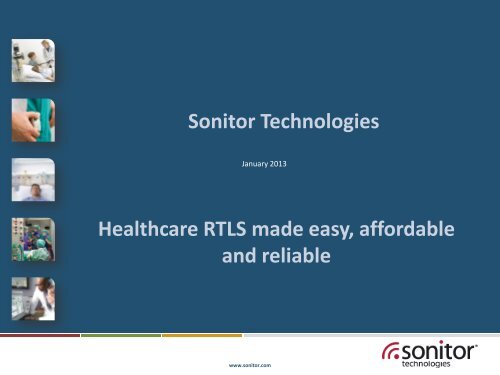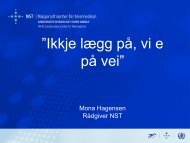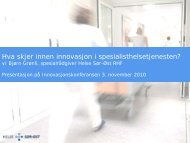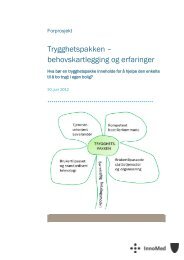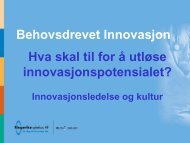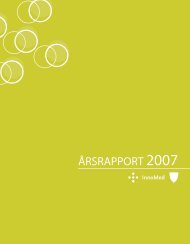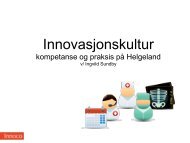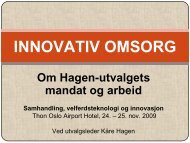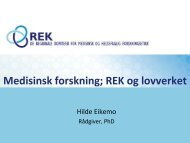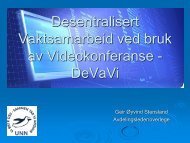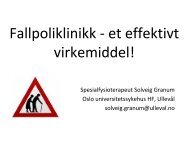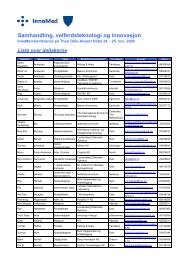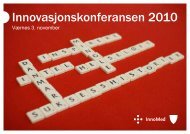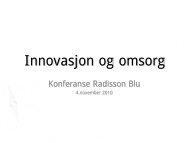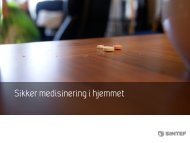Sonitor Technologies Healthcare RTLS made easy ... - Innomed
Sonitor Technologies Healthcare RTLS made easy ... - Innomed
Sonitor Technologies Healthcare RTLS made easy ... - Innomed
Create successful ePaper yourself
Turn your PDF publications into a flip-book with our unique Google optimized e-Paper software.
<strong>Sonitor</strong> <strong>Technologies</strong>January 2013<strong>Healthcare</strong> <strong>RTLS</strong> <strong>made</strong> <strong>easy</strong>, affordableand reliablewww.sonitor.com
AGENDAAgenda• <strong>Sonitor</strong> Introduction• How the system works• Why UltraSound• <strong>RTLS</strong> Applications overview• Asset Management case studywww.sonitor.comwww.sonitor.com
SONITOR<strong>Sonitor</strong> Background• Founded in 1997 by Ole B. Hovind (MD)• Commercial launch in 2004• HQ in Oslo, Norway• US Sales & Support office in Seattle (USA)• 100% focused on <strong>Healthcare</strong> market• 17 Patents• <strong>Sonitor</strong> offers Hardware, Server Softwareand OEM components• Access to location data for applicationpartners’ software through <strong>easy</strong>integration to the <strong>Sonitor</strong> serverwww.sonitor.comwww.sonitor.com
SONITOR PARTNERSSelected Partnerswww.sonitor.comwww.sonitor.com
SELECTED REFERENCESSelected Hospitalswww.sonitor.comwww.sonitor.com
ULTRASOUNDHow <strong>Sonitor</strong> USID workswww.sonitor.comwww.sonitor.com
COMPONENTS<strong>Sonitor</strong> componentsThe <strong>Sonitor</strong> platform has three components:• The tags – worn by patients and hospital staff or attached to any mobileequipment.• The room units – to communicate with tags, collect and relay data to theserver.• The server software – to collect all tag and room data then process andserve it to any <strong>RTLS</strong> application.www.sonitor.comwww.sonitor.com
SONITOR RECEIVER INFRASTRUCTUREWireless InfrastructureIPS Serverwww.sonitor.comwww.sonitor.com
WIRELESS INFRASTRUCTURE - COMPONENTSWireless Infrastructure ComponentsHDR Gateway• Ultrasound Receiver andRF Gateway• Built-in PoE• Supports up to 64Wireless Receivers• Wireless communicationwith server• Up to two zonesWireless Receiver• Three to five yearsbattery life (one zone)• Simple deployment• Health status andupdates over RF• Up to two zones• Flexible placementwww.sonitor.comwww.sonitor.com
TAGSProducts - TagsE-Tag for equipment tracking• Fixed or motion sensor activated• Tether (tamper) option• Configurable interval settings• Communication buttons• Battery: 600.000 transmissionsP-Tag for patient tracking• Single patient use• Disposable outer shell• Reusable Core• Waterproof• Battery: 120.000 transmissionsS-Tag for staff tracking• Two easily identifiable buttons• Three colour LED• Motion sensor• Replaceable battery• Rigid integration with card holder• Card holder in portrait or landscape• 900.000 transmissionswww.sonitor.comwww.sonitor.com
TEMPERATURE TRACKINGTemperature Tracking• Combine high accuracypositioning withtemperature monitoring• On board sensor (i.e.ambient temperaturetracking) or external probe(i.e. freezers)• Using high speed RF fordata transmissionwww.sonitor.comwww.sonitor.com
Why UltraSound ?www.sonitor.com
Patients and staff don’t gothrough walls or windowsRadio andinfrared signals do.www.sonitor.comwww.sonitor.comUltra Sound thinking- when “close” isn’t accurate enough
UltraSound• Logical zones rather than X,Yco-ordinate• The ability to guarantee thatthe tag is within a certainarea, e.g. a Patient Room(room-level accuracy) or adefined zone inside a room(sub-room-level accuracy).RF Triangulation• X,Y co-ordinate as a result ofdifference in signal strength• The ability to guarantee the tagis within a certain radius of alocation, but not room-locationspecific. (XX m. precision)Room 301 Room 303Room 305 Room 307www.sonitor.com
SUB ROOM ACCURACYSub-room accuracy – more ROI applicationsBed level location zonesAutomatic registration of interaction and association workflow events, such as “patient in bed”,“equipment at bed side” and “caregiver at bedside.Spot location accuracy1. Hand sanitation station(Monitoring /Enforcing handwashing compliance)2. Clinician automatic log-on and logoffof computer/patientinformation screenFall detection zone“Patient on floor, send alert”Neutral room zonePresencewww.sonitor.comwww.sonitor.com
<strong>Sonitor</strong> Ultrasound because …• Logical zones rather than X,Y• Easy room level and subroom level with a single receiver unit• High accuracy with bounderies defined down to 30 cm• Robust – no interference• No line of sight requirements• Not affected by bright sunlight• Does not penetrate walls or windows• Easy to deploy with wireless & battery powered infrastructure• Cost effective• Only technology that scales to very high accuracy (“³ )www.sonitor.com
APPLICATIONS<strong>RTLS</strong>: Solutions for critical hospital operationsEquipmentlocalizationAutomatednurse callcancellationPatient/stafflocalizationED & ORWorkflowmanagementContagiousdiseasecontact trackingHand hygienecomplianceAutomatedbilling supportUsing reliable high-accuracy <strong>RTLS</strong> technology based on ultrasound (USID)Localization in general area.Localization in smaller area(e.g. ward.)Localization at room level.Accuracy at sub-room level.Financial return dependent on level of deployment and <strong>RTLS</strong> accuracywww.sonitor.comwww.sonitor.com
ROI in <strong>RTLS</strong> enabledEquipment Managementwww.sonitor.com
Equipment Management• Lots of anecdotal evidence of assetinefficiency- “Hospitals typically over-purchase by 20-30%”- “Hospitals typically lose 5% of theirequipment per year”- “Nurses typically spend 2 hours of each shiftlooking for equipment”• Lots of talk about <strong>RTLS</strong> as the antidote- “Find everything instantly, you don’t need tobuy as much, you won’t lose as much, andeverything will be better”www.sonitor.comwww.sonitor.com
DATA COLLECTIONWorkshop• Relevant staff members from different departments(nursing, BioMed, OR, IT, finance,...)• Goal is to collect input from staff, understand processes,identify waste, select equipment to be taggedEQUIPMENT IS AVAILABLE WHEN I NEED IT5% 11%35% 21%28%12345PRIORITY SCORING FOR TAGGINGMobility Cost of Equipment Critical to Patient Safety Difficult to find/High Demand1 - Does not normally move 1 - Higher than € 500 1 - Non critical 1 - Low demand2 - Moves 1-2 times/month 2 - Higher than € 1,000 2 - Slightly critical 2- Medium demand3 - Moves several times/week 3 - Higher than € 5,000 3 - Moderately critical 3 - Moderately high demand4 - Moves up to once per day 4 - Higher than € 10,000 4 - Highly critical 4 - High demand5 - Moves multiple times / day 5 - Higher than € 25,000 5 - Very highly critical 5 - Very high demand400 assets to tagwww.sonitor.comwww.sonitor.com
LOST ASSETSReduction of lost assetsProblem Statement21%• After careful selection of most important equipment to track, 21% of the assetscould not be found even after several weeks.• Value of lost equipment is calculated at € 324,00079%Solution• Reduce amount of lost equipment, using <strong>RTLS</strong> tracking system , to alertstaff that equipment is leaving the defined area• Alert when equipment that is not moving for x time (hoarding)ImpactReduction of lost equipment Value (€)80% 259,20070% 226,80060% 194400www.sonitor.comwww.sonitor.com
ROI DRIVERSIncreased staff productivityProblem Statement• Enormous amounts of time are wasted every day insearching for equipment• Average search time = 28 minutes• BioMed engineers searching 3x / day• Nurses searching 3x /shift• 6 monthly inventory countsItem Average Minimum MaximumAlaris Pump 18 3 65Epidural Pump 35 35 35PCA pump 32 2 127Sonosite 5 5 5Syringe pump 31 2 65Total 28 2 127SolutionAccurate <strong>RTLS</strong> provides immediate visibility on Equipment location, so asignificant reduction in search time is realizedImpactNew Search time Value (€)2 min 532,9485 min 471,4568 min 409,968www.sonitor.comwww.sonitor.com* Based on 30 wards
UTILIZATIONImproved utilization ratesProblem Statement• Observations & analysis highlighted low levels of utilization forPCA pumps (< 20%)• Staff experience non-availability and regularly have to look forthem on the wards.• A recent availability search could not locate 10% of the totalnumber of PCAsSolution• <strong>RTLS</strong> to provide better visibility combined with process redesignto increase availability of PCA’s for staff and reduceturnaround time from ward to recoveryPCA Pumps• Highly mobile, continuallycirculating between departments• Staff feedback regarding(un)availability• Problematic asset for Biomed –high number of reported userissues• BioMed touch ratio : 1.8/yr• Average purchase price €2,640• Max 25% of pumps used dailyImpactNew utilization rate # pumps Value (€)60% 35 187,44050% 43 166,32040% 53 139,920+ 15% annual maintenance costExtrapolate to other equipment groups to increase savings x-foldwww.sonitor.comwww.sonitor.com
PATIENT SAFETYImpact on Patient SafetyImproved compliance on preventive maintenance• Research amongst a set of European clients shows that up to 30% ofmedical equipment is past due on the preventive maintenance / calibrationcycle• Number 1 reason quoted by BioMed engineers : “I can’t find it”Accurate real-time location of equipment ensures that BioMed engineerscan easily find assets, improving compliance on Preventive MaintenancePar level management in ICU• Analysis showed poor inventory level management of critical medicalequipment in ICU department• Often excess inventory was found, but occasionaly imprtant equipmentcould not be foundSetting minimum and maximum levels of each type of equipment with alertsavoids waste in inventory and ensures that critical equipment is always athand when neededwww.sonitor.comwww.sonitor.com
Thank YouRoby PeetersE : roby.peeters@sonitor.comM : +32 475 61 08 84Skype : roby_peeterswww.sonitor.com


